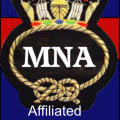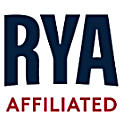Steve Walker
This year we have had our first experience of coastal cruising having been a canal and
river dodger in my younger years on my fathers boat. He was very active in Torksey
Yacht Club on the Trent and Boston Motor Yacht Club on the Witham. In his latter
years spent a lot of time cruising the Wash and the River Great Ouse basing his boat at
Denver Sluice.
A move to the South in 2001 through work when after I came ashore in 1996 meant
boating was on hold for me. However, its gets under your skin and we soon had an 18
foot day boat which we towed to Chichester followed in 2007 by a 25 foot sports boat.
Last year we decided to bite the bullet and take on the financial burden of a larger boat
which we found going for a song in Italy. We cruised the Solent extensively and cruised
to Poole at Srping Bank and then to Falmouth and the West Country in August. All I can
say is what a summer.
Prior to our West country cruise we signed up to the coast guard scheme and always call in a passage plan on longer trips.
I've attached a couple of shots from the summer of "Sachem", we are based in Birdham Pool if anyone in the club is local we'd be
happy to cruise in company next season.
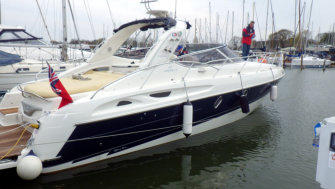
SACHEM
Barry Wiles
I served with Orient Line/P&0 Orient Line between 1957-1970 as electrical officer then
1st electrical officer. Took to the water again in 1974 sailing dinghies for a number of
years, went offshore in 1986 then purchased a share in a syndicate in Greece.
Current Greek yacht is Jeaneau 36. In 2001 went into partnership in UK, purchased
‘Aranhod’, a Legend 29, to sail out of Holyhead.
My cruising area has been Isle of Man, West Scotland, Ireland, N Ireland and Wales.
However this will be restricted to the Welsh coast and Anglesey in future years, out of
Holyhead Marina.
I hope the story below may be of interest.
Philip York
I started sailing with the naval section of the CCF at Solihull School in the 1950’s, primarily in a cadet dinghy ,with occasional forays to
Portsmouth sailing whalers. After a one month course at the Aberdovey Outboard Bound sea school I joined Alfred Holt (Blue Funnel)
as an articled apprentice (midshipman).
4 years followed of sailing primarily to the far east before sitting my 2nd mate’s FG
certificate. Finding the coastal work very interesting, but the long sea passages very
boring, I opted to ‘swallow the hook’ and follow a new career in agricultural engineering
subsequently specialising in irrigation. Progressing through the various development
phases to running the UK subsidiary of a large US irrigation equipment manufacturer
and eventually my own consultancy business.
Meanwhile, pursuing my love of the water, I progressed from dinghy sailing to cruisers,
racing around the cans in Christchurch Bay and cruising the South coast, latterly having
sold my Sonata and subsequent Griffon opting for more comfortable conditions with a
Degero 28MS which we have sailed from Christchurch to Falmouth on the South coast
and across the Channel to N. Brittany’. Other sailing has been chartering in the Baltic,
Norway and the Greek islands.
RYA qualifications: Coastal skipper, power boat level 2, CEVNI. Other courses attended: Radar, first aid and VHF
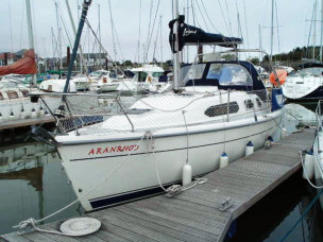
ARANHOD
Cruise to Skye July 2005 by Aranrhod Legend 29 from Holyhead Marina
For my summer cruise in 2005 I thought “why not make a trip to Skye?” and arranged to rendezvous at Kyleakin with my daughter
and her husband who live in Inverness. My friends Ken and Mike expressed an interest so off we went.
The first few days were uneventful. We motor-sailed to Peel, Portpatrick, Ghia and Oban with good weather and the wind always
eluding us. We did experience a blow on our passage to Eigg. However, it was on the nose, arriving about half tide. We tried to
anchor off but, each time we attempted to, we dragged our anchor in the kelp, so be warned. Eventually there was enough water
alongside ans we tied up.
Eigg is a quiet, interesting, place but luck was with us. They have a tea room/bar on the island. The bar (in the tea room) only opens
one evening a week and we got lucky. There is a first rate quay there with a flat sandy bottom.
Our next island was Skye. We arrived in good time and anchored in Isle Ornsay Harbour until it was safe to take the narrow
passage. With a 6 knot tidal flow we soon shot through and arrived at our Kyleakin destination around 6pm, to be greeted by my
daughter.
We enjoyed a great evening and then had a rest day before setting of on the Monday for the journey home, our first port of call being
Tobermoray. Winds were still slight and on the nose so more motor-sailing in the sunshine.
The next day we decided to head for an anchorage. As the tides were wrong to get to Oban, it meant going through the Cuan sound,
we enjoyed a fine evening having a cocktail and counting sheep. in Barnacarry Bay.
Taking the tide down the Cuan sound was uneventful so we pushed on towards Ardfern. You guessed it, motor-sailing. A few hours
later we were enjoying a steak and ale pie at the local pub.
Leaving Ardfern we decided to make for Giha as we needed a fair tide to pass the Mull of Kintyre towards Portpatrick. With no wind
to assist it was motoring again.
In Portpatrick the harbourmaster forecast a 3-5 south-westerly for the next leg to Peel. At 10am, after filling with diesel, we set off.
The trouble in UK waters is, if you intend to do 30-40 mile legs, you can’t mess about with fickle winds, much as you would prefer to
sail. 3-4 knots means you are punching the tide at the end of your passage, so we set off under sail and engine again.
I remembered to strike my flags this time as they were starting to look a bit jaded. Unfortunately I should have made a better job of
tying them down!
Our first inconvenience that day was fog patches which lasted ‘til about noon. Still motoring, we noticed the wind and swell was
increasing. Then, about 2pm, Dublin issued a strong wind warning for Malin, not a million miles north of us. The swell and wind
strength increased and, as it was on the nose, the sails were just flogging so we dropped the main first, the jib sheets having fouled.
Our first problem that day was to furl the jib as the sheets had entwined with the flag halyard. No mean feat with the way the boat
was lifting over the swell, now between 3-5 meters and around a force 8-9. Eventually, after cutting the legend flag into shreds, I got
the sheets free. However, on trying to roll in the jib the furling rope parted from the drum. There was nothing for it but to crawl
forward with ties in my teeth to pull down the jib and make it secure. All the time the sea was building.
About this time Dublin advised that a force 10 was imminent in the Malin area. We got the message! Now we were doing 2 knots
going sideways across the swell, the only way to keep steerage and safe Around 5 pm, thankfully, the rain eased off, the
temperature was reasonable and we had a good Sprayhood, Although we were lightly dressed, we were not hypothermic but unable
to make tea or food-up. I guess our minds were on other things.- survival).
The previous day the engine started missing a beat, slowing down on occasions - the harbourmaster advised it may be filter
problems. The same thing was happening today. About every hour it would slow, I would give it a blast and it would settle down.
Night fell and we discovered there was no light in the compass. We were crabbing along with the tide well clear of land so decided to
wait it out as we seemed to be heading towards Chicken Rock Light. Around midnight we could see the lights of Peel which we had
to look at ‘til dawn.
We tied up in Peel’s outer breakwater onto some old fishing boat, very glad to be in, then got our heads down - 12 hours later than
planned. I must have spent around 17 hours at the helm. Access to the inner harbor over the new sill was not until midday. After
tying up we set to clearing the mess, including re-fitting the furling line and retrieving the flag halyards from the shrouds. I inspected
the hull at low water, especially the bows which had taken such a pounding and it was OK. Believe me these Legends are well built.
The primary filter was removed and gunge dropped out, which was a relief. This did the trick in the short term as next day we
motored to Holyhead without incident.
The moral of this story is “do not neglect your primary filter”.
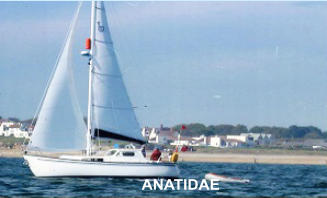
THREE MEN IN A BOAT, UPDATED
Barry, Ken and I spent four days this Spring(2012) in Poros Marine getting Barry’s boat John K a Jeanneau36 ready for the summer
season. All went according to plan apart from Barry and I taking far too long to get the sails on, three goes at the main before we got it
right, we put this down to” old timers” We launched on Friday 24th of April, this entailed the boat being hoisted up from its cradle by
crane, swung between other boats in a very crowded yard and lowered onto a trailer which is then drawn by lorry to the small quay
where the crane lifts it into the water. Amazingly this all went perfectly and after a coffee at eleven o-clock we set off towards the east.
The water was flat calm and as we motored along Ken prepared the lunch, I suggested an Ouzo to celebrate the successful launch
and to look forward to a good trip.
About five miles east from Poros there are two small islands, the course is through the outer channel, it is possible to anchor behind
these islands near to the coast, or you can motor on a mile or two and anchor behind a large rock called Moni, better know as the
Iguana due to its shape. We decided on the latter as the scenery is slightly more interesting, this turned out to be a big mistake. I was
in the bows laying the anchor; I had only just dropped it and let out a few meters of chain in about five meters of water when Barry
called out, “We’ve caught a rope”. I looked down and could just discern a vague yellow broken line running under the boat quite deep
down in the water .I then went to the stern and there it became clear that this was no rope but a fishing net stretching at an angle from
each side of the stern. The engine had stopped and Barry could not get it out of gear nor could he move the tiller. What we said was,”
written on a piece of paper and handed to the magistrate”, as they use to say in the days before Ken Tynan.
It was obvious that a dip in the sea and some serious cutting was necessary, Barry very gamely went in with the carving knife, after
much splashing and struggling Barry said that he was in danger of getting tangled in the net being a bit rotund, I not being a swimmer
but wishing to help, volunteered to go in the dingy and cut each end of the rope and net. The net was made of two quarter inch strands
of polypropylene rope with floats and net slung below then another strand of polypropylene with weights on. The net was brand new
and seriously tough, it took me quite a while to cut through the two sides and free the back of the boat, and allowing Barry to go into
the water safely.
Barry then returned to the task of freeing the propeller with the carving knife. After a while he requested that the knife be attached to a
boat hook as he could not stay under the boat for more than a few seconds. He struggled with this system for a while and then said
that the hook was stuck and could he have the other boat hook. By now lunch time had long passed but tension cuts out hunger we
found. Some time later and after much more struggling Barry came up and said that the second boat hook was also well and truly
stuck, not only that but he was shivering and heading for hypothermia, at least he had managed to free the rudder, which was some
consolation.
We decided that the only course of action was to up anchor and set sail for Ermione about twelve miles further on, even though there
was very little wind. Ken and I went to the bows to lift the anchor and discovered as it came up that it too was entangled in rope and
net. It took us about ten minuets to clear it before we very slowly eased out of the bay and into what wind there was. As we were
creeping slowly towards Ermione we had the lunch that Ken had prepared four hours before, but we did not really do justice to it as we
were worried as to whether the wind would hold . In fact the wind was very patchy and at times we moved so slowly through the water
that the speedometer did not register although bubbles passed by to let us know that we were still under way; our top speed did reach
a heady three knots for a while around seven o-clock. We finally reached the entrance to the long inlet leading to Ermione by about
nine at night just as the light was fading fortunatly there were no hydrofoils plying there trade. Barry and Ken then lowered the
outboard onto the dinghy which we had tied to the side of the boat, and using this means of propulsion we manoeuvred to just outside
the harbour and dropped the anchor. We then made a quick meal on board and had a good session on the wine getting to bed
somewhat relieved that we had not had to travel all those miles just on dinghy power.
The following morning we let out more anchor and roped the boat back and alongside a new extension to the mole. We then went in
search of a diver, a girl in a chandlers was very helpful in this respect. When she telephoned for the diver she showed no surprise at
our request, this was rather suspicious we thought, maybe it is a fisherman’s plot to earn money on the side. This theory was
squashed however since the net had been brand new and I do not suppose they come cheaply.
At about twelve o-clock the diver arrived all kitted up, he had his young son with him to do the translating, we explained the situation
pointing to the two boat hooks sticking out from under the stern. The diver promptly dropped into the water and spent ten minutes
below the boat, he then passed up a tangled mass of net containing both hooks then returned carry on to free the propeller. I then
spent the next ten minutes cutting the boat hooks free, the net with its ropes was seriously tough and we realised that Barry had stood
no chance at all of clearing it without diving gear. After yet another long session below the diver came up and announced, via his son,
that the propeller was clear, but could we then start the engine to make sure that there was no serious damage. Much to our relief it
worked, though what was not a relief was his fee, a matter of one hundred and fifty Euros, then equal to the best part of one hundred
and fifty pounds; however, as Barry pointed out, we were over the proverbial barrel!
The moral is, be very careful when anchoring in Greek bays, however well used by yachties, some fisherman might have set their
nets with no warning buoys at all as was the case here.
A cautionary tale by Barry Wiles ARANRHOD pp David Mitchell


Page 4 of 4
Page 4 of 4
Richard Card
My father served in the Merchant Navy before and during
World War 2 (Cunard-White Star Line). As a boy, I longed to
follow in his footsteps. However, in my teens I was persuaded
to seek a career in the law which I duly did, although instead of
practising I stayed on the academic side, ending up as a
Professor and Law School Head. I learned to sail in Poole
Harbour in a Portchester Duck when 12 and graduated through
a couple other rather hairier dinghies, which I sailed at Poole
and on the Thames, until I went to University and started
courting the girl who is still my wife. My wife was not a sailor
but not long after our marriage we bought a small motor boat.
Not long afterwards we hired a motor cruiser on the Broads.
We hired again each year in the 1970s for a further three
years. Since then, having discovered the delights of the
Broads, all our boating has been on the Broads, apart from
holidays for eight years sailing in Cornwall. In 1978, we bought
Ness Nomad, an Albin 25. We still have her; she is our pride
and joy. We also have a keelboat and a couple of sailing
dinghies for social sailing rather than racing. We are based on Barton Broad, to which we used to do a round trip of 250 miles, until I
retired 13 years ago. We now live in Beccles on the Southern Broads, near to Richard Winterburn, another MNA BC member. For a
number of years, I chaired the Eastern Region Committee of the RYA and the Norfolk and Suffolk Boating Association, of which
organisations the MNA BC is an affiliated member. I continue to be active in the Norfolk and Suffolk Boating Association but now as its
President.
Recognising what the UK owes to the Merchant Navy, I am honoured to have been admitted to membership of the MNA and MNA BC.
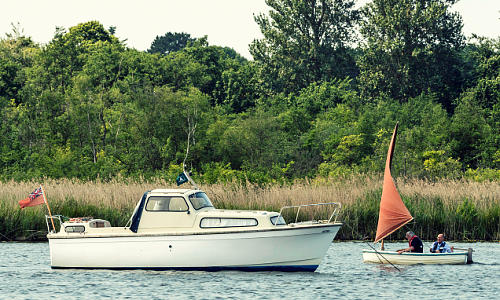
NESS NOMAD
Martin White
After coming ashore in the late 80’s having ended up as 2nd / relief Chief
engineer on a North Sea survey ship, I’ve managed to stay pretty much
connected to the marine industry, looking after the engineering maintenance of
various vessels including Military ships and high speed ferries. I also gained my
MCA boat masters qualification for the Solent area. During my working life I kept
a sailing boat, starting with a slightly worn out Sadler 24 and finally a Degro 34
built in Finland, my family and I enjoyed some great holidays and cruising.
When I retired, my wife decided that her days “before the mast” where over! Time
to give up the sea or buy a motorboat, of course I chose the latter! We went off to
the Netherlands to look at the beautiful boats built by the Neptune yard in Aalst.
We are now the proud owners of “GoGo” an Elling E4 , our boat built in 2015 has
a 425hp Volvo main engine, a 35 hp wing engine as well as a generator and
inverter, thus providing all the comforts herself could desire ( well almost ). Our
usual cruising takes us to the Channel Islands and Brittany. The area around St.
Malo is beautiful in particular,
we have found the little town of St. Cast to be welcoming and well worth spending
a week or two exploring the region, whilst based in the friendly and efficient Marina.
Unlike most other Marinas, St Cast has a work boat that will welcome you in and show you to your berth. An extra bonus is the town is
full of excellent restaurants!
However, it would appear that Covid/ Brexit might have scuppered this particular cruise, at least in the near future, so it’s off to the West
Country and possibly the Channel Islands for us this year. Of course all weather dependant.
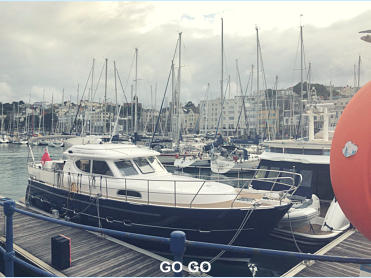
Nicandro Porcelli
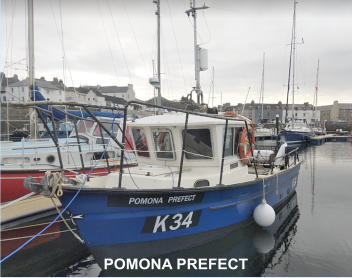
I am based on the Orkney Island of Stronsay. The boat is a MECAL Coded
Workboat, a Hardy 24 Fastfisher. It is an MCA Registered Fishing Boat with a
license PLN K34 and is geared for scallop diving and commercial work.
For more information see his website: http://www.pomonaprefect.com/
Merchant Navy Association Boat Club
(Affiliated to the Merchant Navy Association National Charity)
MEMBERS CONTRIBUTIONS
Please send YOUR contribution to us for inclusion here.
Anything which may be of interest to other members will be welcomed. For example: career details, anecdotes, current
boat details (with photo if available), comments and opinions on the contents of the website etc. Email Clive Edwards at:
clivecgedwards@gmail.com
Click to view:

